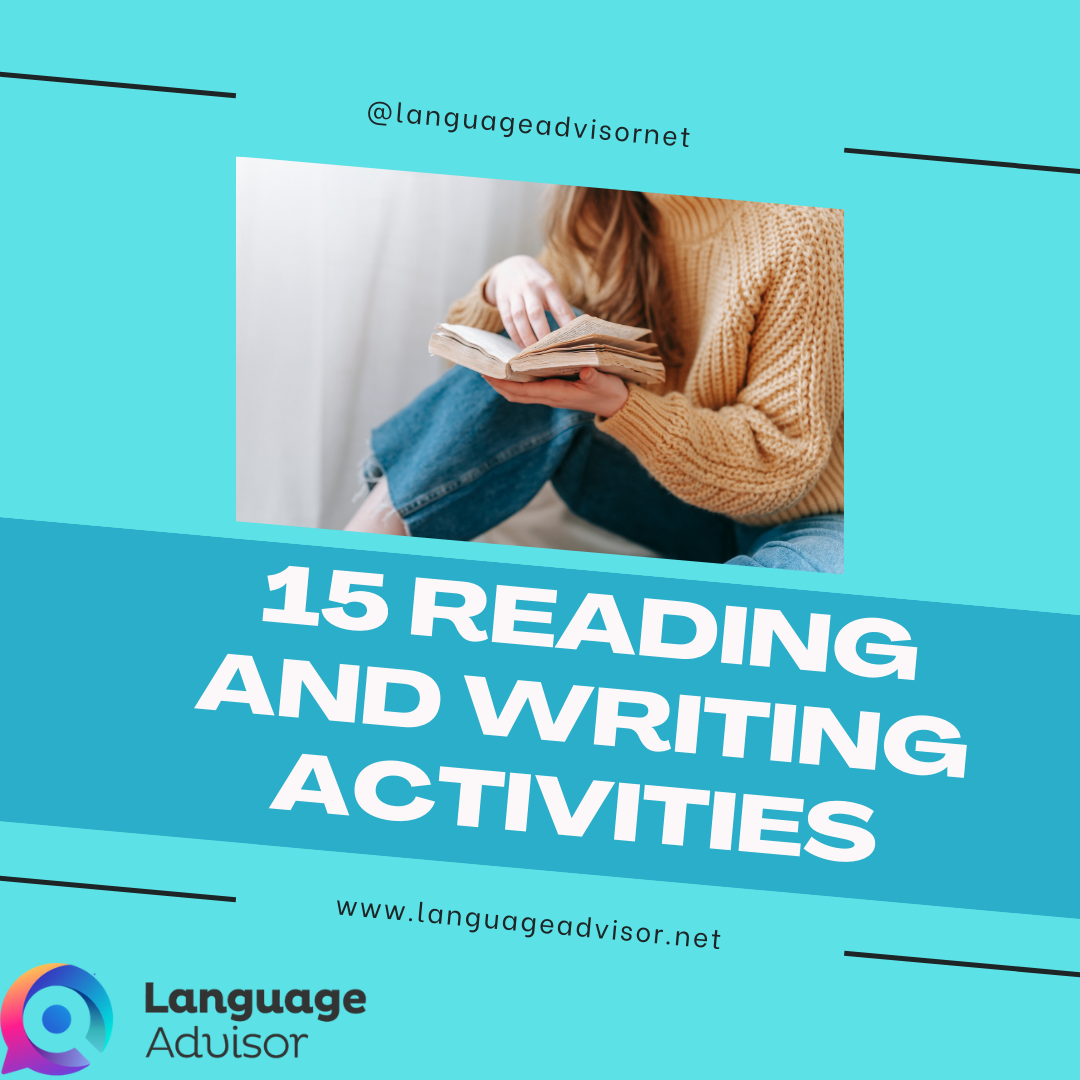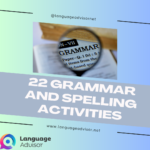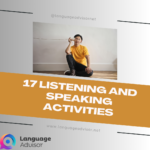15 Reading and Writing Activities. Communicative Activities and Games for Learning English providing crucial opportunity for practice
15 Reading and Writing Activities

15 Reading and Writing Activities
15 Reading and Writing Activities. Coming from a variety of teacher resource books, the activities listed in these pages are designed to foster communication through high-interest and motivational tasks. Each of these activities provides the crucial opportunity for practice that is so essential to the successful acquisition of a foreign language.

Missing Words
Take two photocopies of the same text. White-out different words in each text; or the same words in some cases, but not in all. Photocopy each of the resulting texts with omitted words so that each pair of students has two different texts. Each student then reads the text to his/her partner and together – without showing each other the text – they fill in the missing words to create the whole. This activity will be most successful if the text that you select is a high-interest and entertaining story or article. The students should feel a real desire to know what it says, as well as a motivation to complete the task for the assignment itself.
From Games for Language Learning by Andrew Wright, et al.

Crazy Definitions
This is for high intermediate+ students. Encourage the students to open their English dictionaries to any page and choose an unfamiliar word at random. They should then write down the definition of that word and create two other, phony definitions. This often has very funny results. Students then read the word and definitions to the class and the class votes on which is the correct definition. (This can also be played in teams)
The game can be made easier for the students by using it as a listening game with all of the words and definitions prepared by the teacher.
Based on the game “Balderdash”

Skimming for Information
Students are put into pairs. Each pair is given a different newspaper or magazine article. They are given time enough to skim the material (following instruction on skimming techniques, this is an excellent practice task). After skimming the text, the pair writes down the three most important aspects of the text. (Allow just a matter of a few moments for this, be sure that students do not have enough time to “read” the text word for word). Then take away the text from the students and ask each pair to act out an improvised scene that shows the three most important things that they learned from the text. This is a particularly effective activity in a business setting or for students who are learning English for special purposes or for academic skill development. The texts selected can be chosen for the pertinent and relevant nature of the material to the students. With a larger class it is fun to have 2 or more pairs receive the same text, to see how it is interpreted differently.
From 101 Communicative Games for the English Classroom

Flashcard Commands and Questions
This is excellent for beginners. Commands are written on cards, e.g. open the door, shut the window, stand up, turn around 3 times, go to the door, leave the room, draw a house on the board, etc. Students raise their hands to respond to the commands – select a student and ask them to act it out without reading it aloud. Then ask the class to read what it says. An alternative is to write questions which the students respond to in the same way: what time is it?, Where is my purse?, How many students are in the class?, etc.
From Language Teaching Games and Contests by W.R. Lee
15 Reading and Writing Activities

Treasure Hunt
In order to find the “treasure” the players must be able to read the clues. The clues are hidden around the room and each clue leads to the next. There is a different set of numbered clues, marked a different color for each group of 4-6 students. Each group is given an initial clue, and these clues should lead one to another, e.g. Look under the window and find a box. (In the box the students will find the next clue…) This is definitely an activity for a small class – I have had great success with a class as large as 18. You can do it with pairs or even individuals (if your class is small enough) instead of small group. It does require a bit of effort in preparing the clues, but this is really worth the time and energy. The treasure can be candy or pencils or some prize or just a final message and a picture of a treasure chest or a rainbow declaring the treasure hunters victorious.
Variation: Did you find it? – Students form groups of 4 or work in pairs – depending on class size. Each group is given a bag with 5-8 objects in it. The students are instructed to hide the objects around the class and to write clues for other students to find the objects (don’t worry about students watching other groups, I have found that they are so involved in their group tasks that they don’t pay attention to the other groups at this stage.
If you are very concerned about losing the momentum of the task because some students may watch the others, you can have the students write the clues on Monday, you hide the objects according to their instructions on Tuesday before class begins, and then the students proceed with the treasure hunt). After hiding the objects and writing the clues, groups exchange empty bags and clue lists with other groups. They then go about following the other group’s directions to find and collect (in the bags) each of the objects.
From Language Teaching Games and Contests by W.R. Lee

Where’s that Number?
Write numbers on pieces of masking tape and then hide them around the classroom. Have students pair-up. They write the numbers 1 through (however many you hid, maybe 20 or more), then they start searching for the numbers. This is an excellent review activity for prepositions of place as you make sure that you tape the numbers on, in, under, next to, near, beside, beneath, on top of, at the back of, between, etc. When they find the numbers they write a sentence next to the number on their paper identifying where they found it “1 is on the teacher’s desk” . The first pair to find all the numbers and have a complete list wins the game.
Go over the answers with the whole class, removing the numbers as each are called out. You can also hide vocabulary words written on the tape, and students can then write sentences such as: 1. A cat is on the teacher’s desk; 2. A book is under the window; etc.
From Gold Mine by Melvin S. Shantz

Reconstructing the Story (Strip Stories)
A short story (about 10-20 sentences) is cut-up into sentences and even phrases. The way that you cut-up the story depends on the size of the class, you want to make sure that everyone in the class will be participating. The teacher reads out the first sentence and the student with that sentence stands up. The next sentence is then determined (not by teacher direction, but by student deduction), that student stands up and the first student reads sentence 1, the 2nd student reads sentence 2 and it continues with the story being read, over and over until it takes shape in its entirety with everyone in the class standing up and reading a part of the story. This method can be used very effectively to introduce dialogues.
From Language Teaching Games and Contests by W.R. Lee
Variation: Jigsaw Sentence Race – An envelope filled with sentences cut into strips is given to each team. The first team to correctly put together the story wins.

Sentence Starters
Write a sentence starter on the board, e.g. Being young is… Ask the students to call out what they think could be added to this sentence beginning. After writing several possibilities on the board, ask the students to work in pairs to choose 3 of the sentences. Instruct them to put their chosen sentences into an order they feel comfortable with, then tell them to write a final line to draw it all together as a poem, e.g. Being young is being with friends, being young is not always easy, being young is wondering about the future. Possible starters: Being old means… Boredom is… Love is… A friend is… Without you… I remember… I’ve forgotten… I wish… If I could…
From Five Minute Activities by Penny Ur and Andrew Wright

Compliments Game
Teacher gives each student an envelope. Inside each envelope are small strips of paper, as many strips as there are students, plus one for the teacher to write on. Students write their names on the envelope and pass the envelopes to the right. The student takes out a strip of paper, writes a compliment about the student whose name is on the envelope and returns the paper to the envelope. Students continue passing envelopes, writing compliments, until the envelope returns to its owner. You must choose your audience carefully – you will want to make sure that the maturity level of the students is appropriate for the task.
From Sandra Heyer and Sharron Bassano, TESOL Conference, Long Beach
15 Reading and Writing Activities

Birthday Gifts
This is another feel good activity that’s really super for celebrating students’ birthdays. Decorate the outside of an envelope with pictures of birthday cakes, candles, etc. (Stickers are great for this) and put the name of the birthday student on the envelope. Ask each other student to write the name of a present that he/she would like to give. Put all of the papers in the envelope (pictures of gifts, or pictures cut out of magazines can also be used – such pictures can be gathered together in advance, in anticipation of upcoming birthdays). The student opens the gifts one at a time and tells the class what he/she received. It is really super to establish this as a routine – celebrating everybody’s birthday in a given month so that the focus is not on one student – if you don’t have enough students with birthdays falling during the school term, you may celebrate everybody’s birthday at the end of the quarter, etc.
From Drawing Out by S.Bassano and M.A. Christison

Short Story Continuation
The teacher dictates the beginning of a story that every student writes down word for word. As the teacher leaves off, the students are instructed to add to the story (allow no more than 2 minutes for this). When the students are finished, they fold the paper down to cover all but the last line on the paper, then they pass it to the student on their right. The stories continue on in this way going all the way around the room. After each student has received his/her own paper back, ask students to volunteer to read the resulting stories.
This can be very creative and funny and works well with a range of students from high beginners to advanced.
From 101 Word Games by George P. McCallum

The 5 W’s
Divide the class into teams. After discussing the 5 w’s – who, what, when, where, why – present a sentence on the overhead projector and ask the students to identify the word or words that tell either who, what, when, where or why in that sentence. Move from team to team, giving points for correct answers. e.g. Which word(s) tell “who”? – Our principal made an important announcement today; My grandfather is visiting from Florida; which words tell “what”? – During the storm a tree fell on our roof; Yesterday I polished my father’s car; which words tell “when”? We had fun in school today; Nancy was late coming to school this morning;which words tell “where”? We played on the beach all day; My cat likes to hide under the furniture; which words tell “why”? My friend is staying with us because her mother is out of town; School was closed due to the storm; etc. You can create any variety of sentences to address the 5 w’s.
This is very effective in helping students in narrative paragraph/essay writing.
From Mind Joggers by Susan S. Petreshene

Writing From Headlines
For high intermediate and advanced students. Select newspaper articles and cut out the headlines for the articles. It’s helpful to photocopy the headlines onto firm paper – this is good because you will find that you can give the same headlines to more than one group and arrive at different responses and very different accompanying articles in their follow-up homework. Cut the headlines up into individual words. Place all the words for 3 headlines into an envelope. Divide the class into groups of 3. Give each group an envelope with the words for 3 headlines. Tell them to work together to assemble the headlines. Then ask the group to read the headlines and explain what they mean. For homework each student selects a headline and writes and accompanying story.
From Recipes for Tired Teachers by Christopher Sion

Collaborative Narrations
A different picture is handed out to each group of 3 to 5 students. The teacher dictates the beginning of a sentence about the person or object in the picture. One student in each group writes the beginning of the sentence and completes it. That person then passes the paper to the next group member. The teacher continues the dictation, until a short story has been written by the group about the picture. The groups then share their picture and story with the class.
From Recipes for Tired Teachers by C. Sion
15 Reading and Writing Activities

Dialogs from Pictures
Give each pair of students a picture that has two or more people in it, or two different pictures, each of which has one person in it. Instruct the students to create a dialog between the people in the pictures. This can be a really funny activity allowing for a great deal of creativity and imagination. It can be controlled by the teacher for certain kinds of language functions (e.g. instruct the students to have one person in the picture issue an invitation to the other, the other must respond, etc., or instruct the students to develop a conversation using certain kinds of idiomatic expressions that they have learned in class, or instruct the students to have the people in the pictures discuss certain topics, such as talking about family, jobs or hobbies, etc.)
From Fun with Grammar by Suzanne Woodward

15 Reading and Writing Activities. Also check out these reading and writing activities












